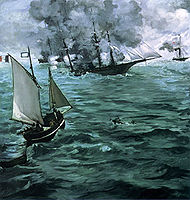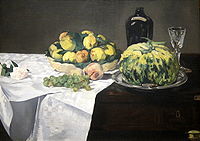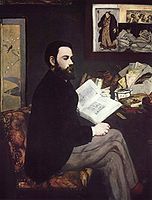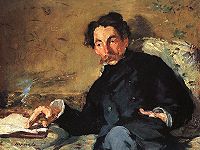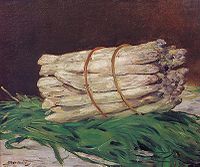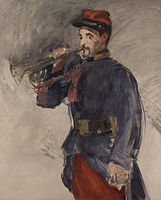- Édouard Manet
-
"Manet" redirects here. For other uses, see Manet (disambiguation).Not to be confused with Claude Monet, another painter of the same era.
Édouard Manet 
portrait by Nadar, 1874Birth name Édouard Manet Born 23 January 1832
ParisDied 30 April 1883 (aged 51)
ParisNationality French Field Painting, printmaking Movement Realism, Impressionism Works The Luncheon on the Grass (Le déjeuner sur l'herbe), 1863
Young Flautist or The Fifer (Le Fifre), 1866
Olympia, 1863
A Bar at the Folies-Bergère (Le Bar aux Folies-Bergère), 1882Édouard Manet (US: /mæˈneɪ/, UK: /ˈmæneɪ/; French: [edwaʁ manɛ]; 1832–1883) was a French painter. One of the first 19th-century artists to approach modern-life subjects, he was a pivotal figure in the transition from Realism to Impressionism.
His early masterworks, The Luncheon on the Grass (Le déjeuner sur l'herbe) and Olympia, engendered great controversy and served as rallying points for the young painters who would create Impressionism. Today, these are considered watershed paintings that mark the genesis of modern art.
Contents
Biography
Born into an upper class household with strong political connections, Manet rejected the future originally envisioned for him, and became engrossed in the world of painting. The last 20 years of Manet's life saw him form bonds with other great artists of the time, and develop his own style that would be heralded as innovative and serve as a major influence for future painters.
Early life
Édouard Manet was born in Paris on 23 January 1832, to an affluent and well connected family. His mother, Eugénie-Desirée Fournier, was the daughter of a diplomat and goddaughter of the Swedish crown prince, Charles Bernadotte, from whom the current Swedish monarchs are descended. His father, Auguste Manet, was a French judge who expected Édouard to pursue a career in law. His uncle, Charles Fournier, encouraged him to pursue painting and often took young Manet to the Louvre.[1] In 1841 he enrolled at secondary school, the Collège Rollin. In 1845, at the advice of his uncle, Manet enrolled in a special course of drawing where he met Antonin Proust, future Minister of Fine Arts and subsequent life-long friend.
At his father's suggestion, in 1848 he sailed on a training vessel to Rio de Janeiro. After Manet twice failed the examination to join the Navy,[2] the elder Manet relented to his son's wishes to pursue an art education. From 1850 to 1856, Manet studied under the academic painter, Thomas Couture. In his spare time, Manet copied the old masters in the Louvre.
From 1853 to 1856 he visited Germany, Italy, and the Netherlands, during which time he absorbed the influences of the Dutch painter Frans Hals, as well as the Spanish artists, Diego Velázquez and Francisco José de Goya.
In 1856, Manet opened his own studio. His style in this period was characterized by loose brush strokes, simplification of details and the suppression of transitional tones. Adopting the current style of realism initiated by Gustave Courbet, he painted The Absinthe Drinker (1858–59) and other contemporary subjects such as beggars, singers, Gypsies, people in cafés, and bullfights. After his early years, he rarely painted religious, mythological, or historical subjects; examples include his Christ Mocked, now in the Art Institute of Chicago, and Christ with Angels, in the Metropolitan Museum of Art, New York.
Music in the Tuileries
Main article: Music in the Tuileries Music in the Tuileries, 1862
Music in the Tuileries, 1862
Music in the Tuileries is an early example of Manet's painterly style. Inspired by Hals and Velázquez, it is a harbinger of his life-long interest in the subject of leisure.
While the picture was regarded as unfinished by some,[1] the suggested atmosphere imparts a sense of what the Tuileries gardens were like at the time; one may imagine the music and conversation.
Here, Manet has depicted his friends, artists, authors, and musicians who take part, and he has included a self-portrait among the subjects.
Luncheon on the Grass (Le déjeuner sur l'herbe)
Main article: Le déjeuner sur l'herbe The Luncheon on the Grass (Le déjeuner sur l'herbe), 1863
The Luncheon on the Grass (Le déjeuner sur l'herbe), 1863
A major early work is The Luncheon on the Grass (Le déjeuner sur l'herbe). The Paris Salon rejected it for exhibition in 1863 but he exhibited it at the Salon des Refusés (Salon of the Rejected) later in the year. Emperor Napoleon III had initiated The Salon des Refusés after the Paris Salon rejected more than 4,000 paintings in 1863.
The painting's juxtaposition of fully dressed men and a nude woman was controversial, as was its abbreviated, sketch-like handling, an innovation that distinguished Manet from Courbet. At the same time, Manet's composition reveals his study of the old masters, as the disposition of the main figures is derived from Marcantonio Raimondi's engraving of the Judgement of Paris (c. 1515) based on a drawing by Raphael.[1]
Two additional works that are cited by scholars as important precedents for Le déjeuner sur l'herbe are Pastoral Concert (c. 1510, The Louvre) and The Tempest (Gallerie dell'Accademia, Venice), both of which are attributed variously to Italian Renaissance masters Giorgione or Titian.[3] The Tempest is an enigmatic painting that features a fully dressed man and a nude woman in a rural setting. The man is standing to the left and gazing to the side, apparently at the woman, who is seated and is breastfeeding a baby; the relationship between the two figures is unclear.[4] In Pastoral Concert, two clothed men and a nude woman are seated on the grass, engaged in music making, while a second nude woman stands beside them.
Olympia
 Olympia, 1863
Olympia, 1863 Main article: Olympia (Manet)
Main article: Olympia (Manet)As he had in Luncheon on the Grass, Manet again paraphrased a respected work by a Renaissance artist in the painting Olympia (1863), a nude portrayed in a style reminiscent of early studio photographs, but whose pose was based on Titian's Venus of Urbino (1538). The painting is also reminiscent of Francisco Goya's painting, The Nude Maja (1800).
Manet embarked on the canvas after being challenged to give the Salon a nude painting to display. His uniquely frank depiction of a self-assured prostitute was accepted by the Paris Salon in 1865, where it created a scandal. According to Antonin Proust, "only the precautions taken by the administration prevented the painting being punctured and torn" by offended viewers.[5] The painting was controversial partly because the nude is wearing some small items of clothing such as an orchid in her hair, a bracelet, a ribbon around her neck, and mule slippers, all of which accentuated her nakedness, sexuality, and comfortable courtesan lifestyle. The orchid, upswept hair, black cat, and bouquet of flowers were all recognized symbols of sexuality at the time. This modern Venus' body is thin, counter to prevailing standards; the painting's lack of idealism rankled viewers. The painting's flatness, inspired by Japanese wood block art, serves to make the nude more human and less voluptuous. A fully dressed black servant is featured, exploiting the then-current theory that black people were hyper-sexed.[1] That she is wearing the clothing of a servant to a courtesan here, furthers the sexual tension of the piece.
Olympia's body as well as her gaze is unabashedly confrontational. She defiantly looks out as her servant offers flowers from one of her male suitors. Although her hand rests on her leg, hiding her pubic area, the reference to traditional female virtue is ironic; a notion of modesty is notoriously absent in this work. A contemporary critic denounced Olympia's "shamelessly flexed" left hand, which seemed to him a mockery of the relaxed, shielding hand of Titian's Venus.[6] Likewise, the alert black cat at the foot of the bed strikes a sexually rebellious note in contrast to that of the sleeping dog in Titian's portrayal of the goddess in his Venus of Urbino.
"Olympia" was the subject of caricatures in the popular press, but was championed by the French avant-garde community, and the painting's significance was appreciated by artists such as Gustave Courbet, Paul Cézanne, Claude Monet, and later Paul Gauguin.
As with Luncheon on the Grass, the painting raised the issue of prostitution within contemporary France and the roles of women within society.[1]
Life and times
 Berthe Morisot, 1872
Berthe Morisot, 1872
The roughly painted style and photographic lighting in these works was seen as specifically modern, and as a challenge to the Renaissance works Manet copied or used as source material. His work is considered 'early modern', partially because of the black outlining of figures, which draws attention to the surface of the picture plane and the material quality of paint.
He became friends with the Impressionists Edgar Degas, Claude Monet, Pierre-Auguste Renoir, Alfred Sisley, Paul Cézanne and Camille Pissarro through another painter, Berthe Morisot, who was a member of the group and drew him into their activities. The grand niece of the painter Jean-Honoré Fragonard, Morisot had her first painting accepted in the Salon de Paris in 1864, and she continued to show in the salon for the next ten years.
Manet became the friend and colleague of Berthe Morisot in 1868. She is credited with convincing Manet to attempt plein air painting, which she had been practicing since she was introduced to it by another friend of hers, Camille Corot. They had a reciprocating relationship and Manet incorporated some of her techniques into his paintings. In 1874, she became his sister-in-law when she married his brother, Eugene.
Unlike the core Impressionist group, Manet maintained that modern artists should seek to exhibit at the Paris Salon rather than abandon it in favor of independent exhibitions. Nevertheless, when Manet was excluded from the International exhibition of 1867, he set up his own exhibition. His mother worried that he would waste all his inheritance on this project, which was enormously expensive. While the exhibition earned poor reviews from the major critics, it also provided his first contacts with several future Impressionist painters, including Degas.
Although his own work influenced and anticipated the Impressionist style, he resisted involvement in Impressionist exhibitions, partly because he did not wish to be seen as the representative of a group identity, and partly because he preferred to exhibit at the Salon. Eva Gonzalès was his only formal student.
He was influenced by the Impressionists, especially Monet and Morisot. Their influence is seen in Manet's use of lighter colors, but he retained his distinctive use of black, uncharacteristic of Impressionist painting. He painted many outdoor (plein air) pieces, but always returned to what he considered the serious work of the studio.
Manet enjoyed a close friendship with composer Emmanuel Chabrier, painting two portraits of him; the musician owned 14 of Manet's paintings and dedicated his Impromptu to Manet's wife.[7]
Throughout his life, although resisted by art critics, Manet could number as his champions Émile Zola, who supported him publicly in the press, Stéphane Mallarmé, and Charles Baudelaire, who challenged him to depict life as it was. Manet, in turn, drew or painted each of them.
Cafe scenes
Manet's paintings of cafe scenes are observations of social life in 19th-century Paris. People are depicted drinking beer, listening to music, flirting, reading, or waiting. Many of these paintings were based on sketches executed on the spot. He often visited the Brasserie Reichshoffen on boulevard de Rochechourt, upon which he based At the Cafe in 1878. Several people are at the bar, and one woman confronts the viewer while others wait to be served. Such depictions represent the painted journal of a flâneur. These are painted in a style which is loose, referencing Hals and Velázquez, yet they capture the mood and feeling of Parisian night life. They are painted snapshots of bohemianism, urban working people, as well as some of the bourgeoisie.
In Corner of a Cafe Concert, a man smokes while behind him a waitress serves drinks. In The Beer Drinkers a woman enjoys her beer in the company of a friend. In The Cafe Concert, shown at right, a sophisticated gentleman sits at a bar while a waitress stands resolutely in the background, sipping her drink. In The Waitress, a serving woman pauses for a moment behind a seated customer smoking a pipe, while a ballet dancer, with arms extended as she is about to turn, is on stage in the background.
Manet also sat at the restaurant on the Avenue de Clichy called Pere Lathuille's, which had a garden as well as the dining area. One of the paintings he produced here was, Chez le père Lathuille (At Pere Lathuille's), in which a man displays an unrequited interest in a woman dining near him.
In Le Bon Bock (1873), a large, cheerful, bearded man sits with a pipe in one hand and a glass of beer in the other, looking straight at the viewer.
Paintings of social activities
Manet painted the upper class enjoying more formal social activities. In Masked ball at the Opera, Manet shows a lively crowd of people enjoying a party. Men stand with top hats and long black suits while talking to women with masks and costumes. He included portraits of his friends in this picture.
Manet depicted other popular activities in his work. In The Races at Longchamp, an unusual perspective is employed to underscore the furious energy of racehorses as they rush toward the viewer. In Skating Manet shows a well dressed woman in the foreground, while others skate behind her. Always there is the sense of active urban life continuing behind the subject, extending outside the frame of the canvas.
In View of the International Exhibition, soldiers relax, seated and standing, prosperous couples are talking. There is a gardener, a boy with a dog, a woman on horseback—in short, a sample of the classes and ages of the people of Paris.
War
 The Execution of Emperor Maximilian, 1867. Museum of Fine Arts, Boston. The least finished of three large canvases devoted to the execution.
The Execution of Emperor Maximilian, 1867. Museum of Fine Arts, Boston. The least finished of three large canvases devoted to the execution.
Manet's response to modern life included works devoted to war, in subjects that may be seen as updated interpretations of the genre of "history painting".[8] The first such work was the Battle of the Kearsarge and Alabama (1864), a sea skirmish from the American Civil War which took place off the French coast, and may have been witnessed by the artist.[9]
Of interest next was the French intervention in Mexico; from 1867 to 1869 Manet painted three versions of the Execution of Emperor Maximilian, an event which raised concerns regarding French foreign and domestic policy.[10] The several versions of the Execution are among Manet's largest paintings, which suggests that the theme was one which the painter regarded as most important. Its subject is the execution by Mexican firing squad of a Habsburg emperor, who had been installed by Napoleon III. Neither the paintings nor a lithograph of the subject were permitted to be shown in France.[11] As an indictment of formalized slaughter the paintings look back to Goya,[12] and anticipate Picasso's Guernica.
In January 1871 Manet traveled to Oloron-Sainte-Marie in the Pyrenees. In his absence his friends added his name to the "Fédération des artistes" (see:Courbet) of the Paris Commune. Manet stayed away from Paris, perhaps, until after the semaine sanglante: in a letter to Berthe Morisot at Cherbourg (10 June 1871) he writes, "We came back to Paris a few days ago..." (the semaine sanglante ended on 28 May).
The Prints and Drawings Collection of the Museum of Fine Arts (Budapest) has a watercolour/gouache (The Barricade) by Manet depicting a summary execution of Communards by Versailles troops based on a lithograph of the execution of Maximilian. A similar piece (The Barricade), oil on plywood, is held by a private collector.
On 18 March 1871 he wrote to his (confederate) friend Félix Bracquemond in Paris about his visit to Bordeaux, the provisory seat of the French National Assembly of the Third French Republic where Emile Zola introduced him to the sites: "I never imagined that France could be represented by such doddering old fools, not excepting that little twit Thiers..."[13] If this could be interpreted as support of the Commune a following letter to Bracquemond (21 March 1871) expressed his idea more clearly: "Only party hacks and the ambitious, the Henrys of this world following on the heels of the Milliéres, the grotesque imitators of the Commune of 1793..." He knew the communard Lucien Henry to have been a former painter's model and Millière, an insurance agent. "What an encouragement all these bloodthirsty caperings are for the arts! But there is at least one consolation in our misfortunes: that we're not politicians and have no desire to be elected as deputies". (The letters are published in Julliet Wilson-Bareau, ed., Manet by himself UK: Little Brown, 2004.)
Paris
Manet depicted many scenes of the streets of Paris in his works. The Rue Mosnier Decked with Flags depicts red, white, and blue pennants covering buildings on either side of the street—another painting of the same title features a one-legged man walking with crutches. Again depicting the same street, but this time in a different context, is Rue Monsnier with Pavers, in which men repair the roadway while people and horses move past.
The Railway, widely known as The Gare Saint-Lazare, was painted in 1873. The setting is the urban landscape of Paris in the late 19th century. Using his favorite model in his last painting of her, a fellow painter, Victorine Meurent, also the model for Olympia and the Luncheon on the Grass, sits before an iron fence holding a sleeping puppy and an open book in her lap. Next to her is a little girl with her back to the painter, who watches a train pass beneath them.
Instead of choosing the traditional natural view as background for an outdoor scene, Manet opts for the iron grating which "boldly stretches across the canvas"[14] The only evidence of the train is its white cloud of steam. In the distance, modern apartment buildings are seen. This arrangement compresses the foreground into a narrow focus. The traditional convention of deep space is ignored.
Historian Isabelle Dervaux has described the reception this painting received when it was first exhibited at the official Paris Salon of 1874: "Visitors and critics found its subject baffling, its composition incoherent, and its execution sketchy. Caricaturists ridiculed Manet's picture, in which only a few recognized the symbol of modernity that it has become today".[15] The painting is currently in the National Gallery of Art in Washington, D.C.[16]
Manet painted several boating subjects in 1874. Boating, now in the Metropolitan Museum of Art, exemplifies in its conciseness the lessons Manet learned from Japanese prints, and the abrupt cropping by the frame of the boat and sail adds to the immediacy of the image.[17] X-rays and pentimenti indicate that the man originally held the rope in his right hand.[18]
Late works
 Illustration for the Stéphane Mallarmé translation of Edgar Allan Poe's "The Raven", 1875. Digitally restored.
Illustration for the Stéphane Mallarmé translation of Edgar Allan Poe's "The Raven", 1875. Digitally restored.
He completed painting his last major work, A Bar at the Folies-Bergère (Le Bar aux Folies-Bergère), in 1882 and it hung in the Salon that year.
In 1875, a book-length French edition of Edgar Allan Poe's "The Raven" included lithographs by Manet and translation by Mallarmé.[19]
In 1881, with pressure from his friend Antonin Proust, the French government awarded Manet the Légion d'honneur.
 A Bar at the Folies-Bergère (Le Bar aux Folies-Bergère), 1882
A Bar at the Folies-Bergère (Le Bar aux Folies-Bergère), 1882
Personal life
After the death of his father in 1862, Manet married Suzanne Leenhoff in 1863. Leenhoff was a Dutch-born piano teacher of Manet's age with whom he had been romantically involved for approximately ten years. Leenhoff initially had been employed by Manet's father, Auguste, to teach Manet and his younger brother piano. She also may have been Auguste's mistress. In 1852, Leenhoff gave birth, out of wedlock, to a son, Leon Koella Leenhoff.
Eleven-year-old Leon Leenhoff, whose father may have been either of the Manets, posed often for Manet. Most famously, he is the subject of the Boy Carrying a Sword of 1861 (Metropolitan Museum of Art, New York). He also appears as the boy carrying a tray in the background of The Balcony.[20]
Manet painted his wife in The Reading, among other paintings.
Gallery
-
The Spanish Singer, Metropolitan Museum of Art, 1860
-
The Old Musician, National Gallery of Art, 1862
-
Mlle. Victorine in the Costume of a Matador, Metropolitan Museum of Art, 1862
-
Battle of the Kearsarge and the Alabama, Philadelphia Museum of Art, 1864
-
Dead Matador, National Gallery of Art, 1864–1865
-
The Philosopher, (Beggar with Oysters), Art Institute of Chicago, 1864–1867
-
Young Flautist, or The Fifer, Musée d'Orsay, 1866
-
Still Life with Melon and Peaches, National Gallery of Art, 1866
-
The Tragic Actor (Rouvière as Hamlet), National Gallery of Art, 1866
-
Woman with Parrot, Metropolitan Museum of Art, 1866
-
Execution of Emperor Maximilian of Mexico, 1868
-
Portrait of Emile Zola, Musée d'Orsay, 1868
-
Breakfast in the Studio (the Black Jacket), New Pinakothek, Munich, Germany, 1868
-
The Balcony, Musée d'Orsay, 1868–1869
-
Boating, Metropolitan Museum of Art, 1874
-
Portrait of Stéphane Mallarmé, Musée d'Orsay, 1876
-
Nana, 1877
-
Plum, National Gallery of Art, 1878
-
In the Conservatory, National Gallery, Berlin, Germany, 1879
-
''Chez le père Lathuille, 1879, Musée des Beaux-Arts Tournai
-
Bunch of Asparagus, 1880, Wallraf-Richartz Museum, Cologne, Germany
-
The Bugler, 1882, Dallas Museum of Art
-
House in Rueil, National Gallery of Victoria, Melbourne, Australia 1882
-
Garden Path in Rueil, Musée des Beaux-Arts de Dijon, 1882
-
Flowers in a Crystal Vase, National Gallery of Art, 1882
-
Carnations and Clematis in a Crystal Vase, Musée d'Orsay, 1883
Death
Manet died of untreated syphilis and rheumatism, which he contracted in his forties. The disease caused him considerable pain and partial paralysis from locomotor ataxia in the years prior to his death.
His left foot was amputated because of gangrene, an operation followed eleven days later by his death. He died at the age of fifty-one in Paris in 1883, and was buried in the Cimetière de Passy in the city.
See also
- Édouard Manet paintings
- History of painting
- Western painting
References
- ^ a b c d e Ross King. The Judgment of Paris: The Revolutionary Decade that Gave the World Impressionism. New York: Waller & Company, 2006. ISBN 0802714668.
- ^ Édouard Manet, Metropolitan Museum of Art
- ^ Paul Hayes Tucker, Manet's Le Déjeuner sur l'herbe, Cambridge University Press, 1998, pp.12–14. ISBN 0-521-47466-3.
- ^ John Rewald, The History of Impressionism, The Museum of Modern Art, 4th revised edition 1973, (1st 1946, 2nd 1955, 3rd 1961), p.85. ISBN 0-87070-369-2.
- ^ Neret, Gilles. Manet. Taschen, 2003. p. 22. ISBN 3822819492
- ^ Hunter, Dianne. Seduction and theory: readings of gender, representation, and rhetoric. University of Illinois Press, 1989. p. 19. ISBN 0252060636.
- ^ Delage, R. Emmanuel Chabrier. Paris: Fayard, 1999. Chapter XI examines in detail their relationship and the effects of each other on their work.
- ^ Krell, Alan, Manet and the Painters of Contemporary Life, page 83. Thames and Hudson, 1996.
- ^ Krell, pages 84–6.
- ^ Krell, pages 87–91.
- ^ Krell, page 91.
- ^ Krell, page 89.
- ^ Julliet Wilson-Bareau, ed., Manet by himself, UK: Little Brown, 2004
- ^ Gay, p. 106.
- ^ Adams, Katherine H.; Michael L. Keene. After the Vote Was Won: The Later Achievements of Fifteen Suffragists. McFarland, 2010. p. 37. ISBN 0786449381.
- ^ National Gallery of Art.
- ^ Herbert, Robert L. Impressionism: Art, Leisure, and Parisian Society. Yale University Press, 1991. p. 236. ISBN 0300050836.
- ^ Staroilpainting.com
- ^ The Digital Collection of the New York Public Library.
- ^ Mauner, G. L., & Loyrette, H. Manet: the still-life paintings. New York: H.N. Abrams in association with the American Federation of Arts, 2000. p. 66. ISBN 0810943913.
Authority control: VIAF: 97379936Further reading
- Edouard Manet: Rebel in a Frock Coat by Beth Archer Brombert (1996), ISBN 0316109479 and ISBN 0226075443 (1997 paperback)
- Manet by Françoise Cachin (1990 in French; English translation 1991), ISBN 0805017933
- The Drawings of Edouard Manet by Alain de Leiris (1969), ISBN 0520015479
- The Painting of Modern Life: Paris in the Art of Manet and His Followers by TJ Clark (1985), ISBN 0500281793 (2000 paperback edition)
- Manet: Painter of Modern Life by Françoise Cachin (1995), ISBN 050030050X
Short introductory works:
- Manet by Gilles Neret (2003; Taschen), ISBN 3822819492
- Manet by John Richardson (1992; Phaidon Colour Library), ISBN 071482755X
- Ross King. The Judgment of Paris: The Revolutionary Decade that Gave the World Impressionism. New York: Waller & Company, 2006 ISBN 0802714668.
External links
- Paintings by Edouard Manet
- Hecht Museum
- 241 works by Edouard Manet at www.ManetEdouard.org
- The Impressionsts: Manet at biography.com
- Édouard Manet at Olga's Gallery
- Works by Édouard Manet at Project Gutenberg
- Édouard Manet at Hill-Stead Museum, Farmington, Connecticut
- The Walters
- Manet Gallery at MuseumSyndicate
- Manet works at the Minneapolis Institute of Arts
- Édouard Manet at allpaintings.org
- Édouard Manet paintings, media & interactive timeline
- Union List of Artist Names, Getty Vocabularies. ULAN Full Record Display for Edouard Manet. Getty Vocabulary Program, Getty Research Institute. Los Angeles, California.
- Edouard Manet – Images at Artst
- Composition The standing man! at Edouard Manet
Édouard Manet Paintings The Spanish Singer (1860) · Boy Carrying a Sword (1861) · Music in the Tuileries (1862) · The Old Musician (1862) · The Luncheon on the Grass (1863) · Olympia (1863) · The Fifer (1866) · The Races at Longchamp (1867) · The Balcony (1868) · Execution of Emperor Maximilian (1869) · Effect of Snow on Petit-Montrouge (1870) · The Railway (1873) · The Reading (1873) · Nana (1877) · Self-Portrait with Palette (1879) · A Bar at the Folies-Bergère (1882)
Model Impressionism Originators Frédéric Bazille · Eugène Boudin · Gustave Caillebotte · Mary Cassatt · Paul Cézanne · Edgar Degas · Armand Guillaumin · Édouard Manet · Claude Monet · Berthe Morisot · Camille Pissarro · Pierre-Auguste Renoir · Jules Ernest Renoux · Alfred Sisley

Patrons Dealers Artists in USA Other artists Lovis Corinth · Max Liebermann · Max Slevogt · Konstantin Korovin · Valentin Serov · Francisco Oller · Laura Muntz Lyall · Władysław Podkowiński · Nazmi Ziya Güran · Chafik Charobim · Ernest Jean-Marie Millard de Bois DurandOther media See also Decorative Impressionism · Post-ImpressionismCategories:- 1832 births
- 1883 deaths
- Artists from Paris
- French painters
- Realist painters
- Impressionist painters
- Chevaliers of the Légion d'honneur
- Burials at Passy Cemetery
- French intervention in Mexico
-
Wikimedia Foundation. 2010.









